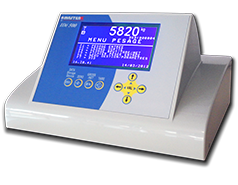PRODUCTS
Weighing indicators for scales or weighbridges
How does it work?
Weighing indicators for weighbridges play a crucial role when weighing road lorries or site machinery.
This equipment operates on a fundamental weighing principle, which is based on detecting the force exerted by an object on a weighing platform. This force is converted into a digital reading, giving users precise information about the weight of their load.
The operating principle of weighbridges is based on a robust structure of steel beams, sometimes supplemented by concrete slabs (e.g. Perfect CPL) and load cells placed under the platform deck. When a vehicle or load is positioned on the weighbridge, the force exerted is transmitted to the load cells, which measure the load exerted on the structure of the weighing system (see weighbridge). This data is then converted into weight units (kgs) by the weighing indicator, providing an accurate reading on a screen or via a computer interface.
What are the benefits?
There are many advantages to weighbridge indicators.
Firstly, they enable efficient stock management by providing accurate measurements of incoming and outgoing materials. This enables companies to control their costs and optimise their logistics processes.
In addition, weighbridges are often used in harsh industrial environments, so they need to be durable and reliable.
Modern weighing indicators are designed to withstand severe conditions, ensuring consistent performance even under extreme conditions.
Weighing vehicles on the road enables maximum weight to be controlled, thus avoiding overloaded lorries, which not only damage the road surface but can also lead to serious traffic accidents.
What technological advances have been made in this area?
As far as technological developments are concerned, weighbridge indicators have undergone significant advances over the years.
One of the major trends is the integration of connectivity and IoT (Internet of Things) functionalities. New weighing indicators are often equipped with intelligent sensors, wireless communication systems and Ethernet connections for easy integration into an office or industrial network.
These new communication methods also enable remote monitoring of weighing operations in real time. This connectivity provides greater visibility of weighing data, making it easier to take decisions and optimise processes.
In addition, the use of advanced data processing and analysis technologies helps to improve measurement accuracy and detect potential anomalies. Error correction and automatic calibration algorithms are built into many weighing indicators, guaranteeing reliable and consistent results.
In conclusion, weighbridge indicators are essential tools for many industries, providing accurate measurement of the weight of materials and goods. Their operating principle is based on detecting the force exerted on a weighing platform, which is then converted into a digital reading. Benefits include efficient stock management and durability in demanding industrial environments. Technological developments such as IoT connectivity and advanced data processing capabilities are helping to improve the performance and accuracy of weighbridge indicators.






